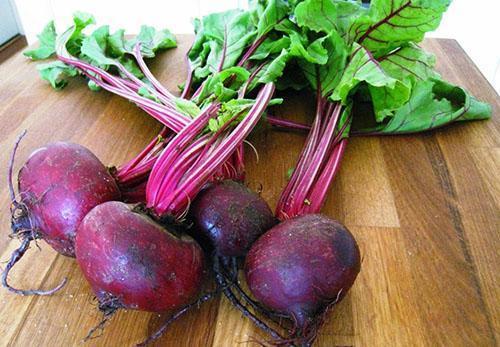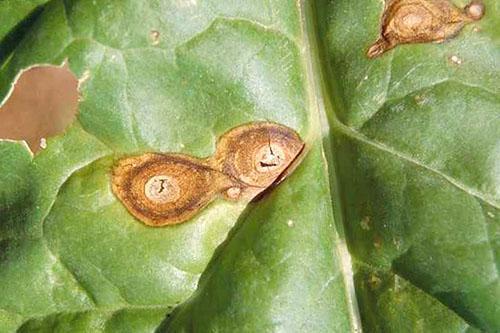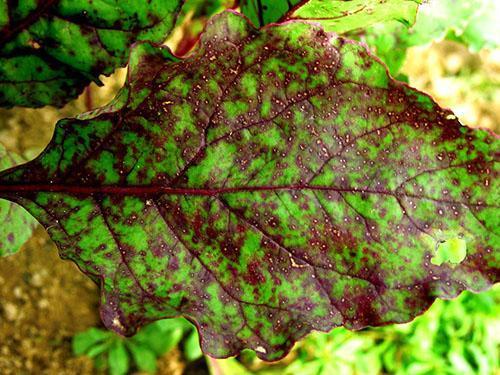Beet diseases and the fight against them: photos and descriptions
 Beetroot is justifiably considered an unpretentious garden crop, which even a beginner can grow. But sometimes strong, healthy tops are covered with reddish and brown spots, the leaves curl and dry out, and the development of root crops is suspended. In this case, even experienced plant breeders have questions. Why do the leaves turn yellow and the beets grow poorly?
Beetroot is justifiably considered an unpretentious garden crop, which even a beginner can grow. But sometimes strong, healthy tops are covered with reddish and brown spots, the leaves curl and dry out, and the development of root crops is suspended. In this case, even experienced plant breeders have questions. Why do the leaves turn yellow and the beets grow poorly?
According to experts, by the tops one can judge the state of the whole plant. There can be several reasons for the deterioration of the health of garden beets. Among them are overly acidic or moisture-saturated soils, lack of mineral and nutrients and interruptions in watering. Unfortunately, it is possible that the plants were attacked by fungi that cause diseases of beets, the leaves of which were the first to react to the infection. At the same time, the appearance of root crops before they enter the storage may not suffer, but in winter you can lose all the harvest.
Descriptions and photos of beet diseases, as well as methods of combating them, will help you notice dangerous symptoms in time, start treating plants and master the simplest ways of prevention.
Phomosis: disease of the leaves of beets and their roots

Why do beet leaves turn yellow, and what to do to stop the process and not lose the crop?
The development of the disease is facilitated by cool rainy weather, as well as the fall of abundant dew in the second half of summer, when night temperatures are already quite low. With gusts of rain and wind, the spores of the harmful fungus spread throughout the plantation, and the causative agent of a dangerous disease of beet leaves waits for the winter in the dead foliage left in the garden bed, on the affected root crops and even on the seeds.
It is noticed that the lack of boron in the soil contributes to the appearance of the disease, and the timely introduction of this microelement, for example in the form of borax, will serve as both a good preventive measure and a means of combating the disease.
Methods of control and prevention:
- The treatment of seeds and root crops with Fundazol helps to protect the beds from the causative agent of phomosis.
- In the last growing season, beet plants are fertilized with products containing potassium.
- We must not forget about following the rules crop rotation, timely weeding of beet rows and thinning of shoots.
- All fallen plant residues from the ridges are removed and burned.
If on the site the disease has already made itself felt, the plantings must be treated with Fundazol or other systemic fungicides. The beets sent to the storage are regularly sorted out, rejecting rotten and soft root crops, after which the containers for vegetables are disinfected and dried.
Beet cercosporosis: what to do if the leaves turn red?
 Gardeners looking for an answer to the question: "Why do the leaves on beets turn red and how to cope with this problem?", Most often face the manifestation of cercospora.The disease is caused by fungal pathogens and is detected by the first reddish and then light spots in the center with a purple or burgundy border that appear on the foliage. If you look at the back of the affected leaf, you will notice a light gray bloom.
Gardeners looking for an answer to the question: "Why do the leaves on beets turn red and how to cope with this problem?", Most often face the manifestation of cercospora.The disease is caused by fungal pathogens and is detected by the first reddish and then light spots in the center with a purple or burgundy border that appear on the foliage. If you look at the back of the affected leaf, you will notice a light gray bloom.
The lower, adult leaves on the outlet are attacked. Gradually the number of stains increases. The size of the foci of this disease of beet leaves grows, and the drying tissue in the center is destroyed.
Plants susceptible to cercosporosis weaken, since diseased leaves die off, and beets spend energy not on the formation of a root crop, but on the renewal of the aboveground green part.
Without effective measures to control beet disease, the propagation of a harmful fungus reduces the yield by almost half. Fodder and sugar beets are particularly affected. The causative agent of cercosporosis is most active in rainy weather at temperatures from +16 ° C, while the spores of the fungus winter on the stems and root zone of perennial weeds, as well as on plant litter uncleaned from the beds.
 As measures to combat the development of the disease, carry out:
As measures to combat the development of the disease, carry out:
- preliminary seed treatment;
- selection of varieties and hybrids resistant to the disease of beet leaves;
- at intervals of 7–10 days, spraying with products containing copper preparations;
- thinning of seedlings at the stage of 2-3 leaves;
- regular weeding of beds and removal of dead leaves;
- selection of a site for sowing, taking into account previous plantings;
- spraying existing plantings with a fungicide.
Beet ramularia
 The spotting of beet leaves, which occurs when plants are diseased with ramulariasis, resembles that that develops with cercospora. However, there are still differences in this beet leaf disease. The foci of the disease in this case are lighter, at first even brownish-green, and small, reaching a maximum of 1.5 cm in diameter. But even inside such small spots, the tissue of the leaf plate dries up, dies and collapses. The crimson or brown border is vague.
The spotting of beet leaves, which occurs when plants are diseased with ramulariasis, resembles that that develops with cercospora. However, there are still differences in this beet leaf disease. The foci of the disease in this case are lighter, at first even brownish-green, and small, reaching a maximum of 1.5 cm in diameter. But even inside such small spots, the tissue of the leaf plate dries up, dies and collapses. The crimson or brown border is vague.
The disease with ramulariasis makes itself felt in the second half of the summer. The first spots can be seen on the lower leaves, and then the disease spreads to both young tops and petioles.
What to do if beet leaves turn red and spots signaling ramulariasis appear on their plates? Since the pathogen can even overwinter on roots and seeds, ramulariasis is observed on seedlings, as well as on peduncles. The fungus develops in a humid environment, at low positive temperatures, causing large losses in the yield of fodder beets, as well as other types of cultivated plants. The fight against beet disease includes both preventive measures and treatment with fungicidal preparations of systemic action, as in the case of cercospora.
Peronosporosis: what to do and why beet leaves turn yellow
 Downy mildew or downy mildew also affects beets in wet weather and is accompanied by yellowing, and then twisting and dying off of the leaf blades. Why do beet leaves turn yellow, and what to do if this disease has struck garden beds? The cause of foliage death is a harmful fungus, whose dispersal and reproduction can be seen on tops covered with brown drying or decaying spots. Gray or purple bloom is clearly visible on the back. These are spores of a fungus ready for further resettlement.
Downy mildew or downy mildew also affects beets in wet weather and is accompanied by yellowing, and then twisting and dying off of the leaf blades. Why do beet leaves turn yellow, and what to do if this disease has struck garden beds? The cause of foliage death is a harmful fungus, whose dispersal and reproduction can be seen on tops covered with brown drying or decaying spots. Gray or purple bloom is clearly visible on the back. These are spores of a fungus ready for further resettlement.
You can save crops from peronosporosis:
- pickling the seeds of this culture before planting in the soil;
- removing plant residues during the growing season and after harvest;
- spraying plants with fungicides.
An effective measure to combat beet leaf disease can be considered periodic treatment of plantings with Bordeaux liquid.
Fusarium: a disease of beet leaves and root crops
 If the gardener notices that the lower leaves of young plants turn yellow for no apparent reason, discolor and wither along with the petioles, this cannot but alert. Why are the leaves yellow and the beets grow poorly in this case? Perhaps the beets in the garden are infected with fusarium. The disease that begins with the leaves of the beet affects not only the tops, but also the roots. In the process of the development of the disease, the foliage decays or dries up, the fungus also penetrates into the tissue of the rhizome, as evidenced by the mycelium visible on the root cut.
If the gardener notices that the lower leaves of young plants turn yellow for no apparent reason, discolor and wither along with the petioles, this cannot but alert. Why are the leaves yellow and the beets grow poorly in this case? Perhaps the beets in the garden are infected with fusarium. The disease that begins with the leaves of the beet affects not only the tops, but also the roots. In the process of the development of the disease, the foliage decays or dries up, the fungus also penetrates into the tissue of the rhizome, as evidenced by the mycelium visible on the root cut.
Why do the leaves turn yellow, and what to do with beets already affected by the disease? Unlike other beet diseases, Fusarium spreads from the root up the plant and can lead to its death.
The greatest harm to the beet disease, as in the photo, causes plantings that lack watering, as well as beets damaged during hilling or weeding.
Protective measures against fusarium beets include:
- feeding with mineral and organic fertilizers, paying attention to products containing boron;
- liming of acidic soils;
- observance of the rules for the alternation of garden crops during crop rotation;
- deep loosening of the soil in the aisles;
- regular and sufficient watering;
- weed and pest control.
Beet plants affected by rot are removed and destroyed so that the infection does not affect neighboring plants.
Beet disease prevention measures
 The danger of beet diseases and the need for effective measures to combat them is due to the fact that the external manifestations of these diseases in the form of reddening or yellowing of leaves are not always equivalent to true damage. Cavities and rot inside root vegetables are only found during storage, when most of the beets are wastedly discarded.
The danger of beet diseases and the need for effective measures to combat them is due to the fact that the external manifestations of these diseases in the form of reddening or yellowing of leaves are not always equivalent to true damage. Cavities and rot inside root vegetables are only found during storage, when most of the beets are wastedly discarded.
Preventive measures are extremely important, which do not give the fungus-causative agents of diseases of beet leaves and root crops, not the slightest chance of consolidation and development.
To this end:
- select hybrids and varieties resistant to fungal diseases;
- observe agricultural techniques for growing beets, including weeding, thinning thickened seedlings and maintaining the cleanliness of the soil under plantings;
- carry out planned feeding of the garden culture;
- crops are regularly examined to detect diseases at an early stage;
- harvest root crops in a timely manner;
- carefully examine the roots that are going to winter storage.
It is important to remember that leaf diseases of beets and their root crops, as well as pests, most often affect weakened plants that are deficient in nutrients, moisture, light and oxygen.
A good selection of beet diseases and a wonderful video by Natalia Petrenko. Thank!
So, I have the initial signs of beet Cerkosporosis. Please tell me the best copper-containing drugs and other measures to combat this disease. Thank!